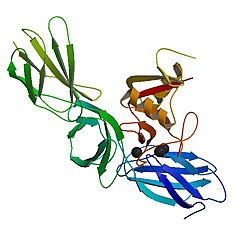
Proteoglycans are proteins[1] that are heavily glycosylated. The basic proteoglycan unit consists of a "core protein" with one or more covalently attached glycosaminoglycan (GAG) chain(s).[2] The point of attachment is a serine (Ser) residue to which the glycosaminoglycan is joined through a tetrasaccharide bridge (e.g. chondroitin sulfate-GlcA-Gal-Gal-Xyl-PROTEIN). The Ser residue is generally in the sequence -Ser-Gly-X-Gly- (where X can be any amino acid residue but proline), although not every protein with this sequence has an attached glycosaminoglycan. The chains are long, linear carbohydrate polymers that are negatively charged under physiological conditions due to the occurrence of sulfate and uronic acid groups. Proteoglycans occur in connective tissue.
Types
[edit]Proteoglycans are categorized by their relative size (large and small) and the nature of their glycosaminoglycan chains.[3] Types include:
| Type | Glycosaminoglycans (GAGs) | Small proteoglycans | Large proteoglycans |
|---|---|---|---|
| chondroitin sulfate/dermatan sulfate | decorin, 36 kDa biglycan, 38 kDa |
aggrecan, 220 kDa, the major proteoglycan in cartilage | |
| Heparan sulfate proteoglycan (HSPGs) |
heparan sulfate/chondroitin sulfate | testican, 44 kDa | perlecan, 400–470 kDa betaglycan, >300 kDa agrin, >500 kDa |
| Chondroitin sulfate proteoglycan (CSPGs) |
chondroitin sulfate | bikunin, 25 kDa |
neurocan, 136 kDa |
| Keratan sulfate proteoglycan | keratan sulfate | fibromodulin, 42 kDa lumican, 38 kDa |
Certain members are considered members of the "small leucine-rich proteoglycan family" (SLRP).[4] These include decorin, biglycan, fibromodulin and lumican.
Function
[edit]Proteoglycans are a major component of the animal extracellular matrix, the "filler" substance existing between cells in an organism. Here they form large complexes, both to other proteoglycans, to hyaluronan, and to fibrous matrix proteins, such as collagen. The combination of proteoglycans and collagen form cartilage, a sturdy tissue that is usually heavily hydrated (mostly due to the negatively charged sulfates in the glycosaminoglycan chains of the proteoglycans).[5] They are also involved in binding cations (such as sodium, potassium and calcium) and water, and also regulating the movement of molecules through the matrix. Evidence also shows they can affect the activity and stability of proteins and signalling molecules within the matrix.[6][7] Individual functions of proteoglycans can be attributed to either the protein core or the attached GAG chain. They can also serve as lubricants, by creating a hydrating gel that helps withstand high pressure.
Synthesis
[edit]The protein component of proteoglycans is synthesized by ribosomes and translocated into the lumen of the rough endoplasmic reticulum. Glycosylation of the proteoglycan occurs in the Golgi apparatus in multiple enzymatic steps. First, a special link tetrasaccharide is attached to a serine side chain on the core protein to serve as a primer for polysaccharide growth. Then sugars are added one at a time by glycosyl transferase. The completed proteoglycan is then exported in secretory vesicles to the extracellular matrix of the tissue.
Clinical significance
[edit]An inability to break down the proteoglycans is characteristic of a group of genetic disorders, called mucopolysaccharidoses. The inactivity of specific lysosomal enzymes that normally degrade glycosaminoglycans leads to the accumulation of proteoglycans within cells. This leads to a variety of disease symptoms, depending upon the type of proteoglycan that is not degraded. Mutations in the gene encoding the galactosyltransferase B4GALT7 result in a reduced substitution of the proteoglycans decorin and biglycan with glycosaminoglycan chains, and cause a spondylodysplastic form of Ehlers–Danlos syndrome.[8]
Distinction between proteoglycans and glycoproteins
[edit]Quoting from recommendations for IUPAC:[9]
A glycoprotein is a compound containing carbohydrate (or glycan) covalently linked to protein. The carbohydrate may be in the form of a monosaccharide, disaccharide(s), oligosaccharide(s), polysaccharide(s), or their derivatives (e.g. sulfo- or phospho-substituted). One, a few, or many carbohydrate units may be present. Proteoglycans are a subclass of glycoproteins in which the carbohydrate units are polysaccharides that contain amino sugars. Such polysaccharides are also known as glycosaminoglycans.
References
[edit]- ^ Proteoglycans at the U.S. National Library of Medicine Medical Subject Headings (MeSH)
- ^ Gerhard Meisenberg; William H. Simmons (2006). Principles of medical biochemistry. Elsevier Health Sciences. pp. 243–. ISBN 978-0-323-02942-1. Retrieved 6 February 2011.
- ^ Iozzo, RV; Schaefer, L (March 2015). "Proteoglycan form and function: A comprehensive nomenclature of proteoglycans". Matrix Biology. 42: 11–55. doi:10.1016/j.matbio.2015.02.003. PMC 4859157. PMID 25701227.
- ^ Hans-Joachim Gabius; Sigrun Gabius (February 2002). Glycosciences: Status and Perspectives. John Wiley and Sons. pp. 209–. ISBN 978-3-527-30888-0. Retrieved 6 February 2011.
- ^ Voet, Donald; Voet, Judith; Pratt, Charlotte (2016). Fundamentals of Biochemistry: Life at the Molecular Level. Hoboken, New Jersey: John Wiley & Sons. p. 235. ISBN 978-1-118-91840-1.
- ^ Ibrahim, Sherif (2017). "Syndecan-1 is a novel molecular marker for triple negative inflammatory breast cancer and modulates the cancer stem cell phenotype via the IL-6/STAT3, Notch and EGFR signaling pathways". Molecular Cancer. 16 (1): 57. doi:10.1186/s12943-017-0621-z. PMC 5341174. PMID 28270211.
- ^ Ibrahim, Sherif (2013). "Syndecan-1 (CD138) modulates triple-negative breast cancer stem cell properties via regulation of LRP-6 and IL-6-mediated STAT3 signaling". PLOS ONE. 8 (12): e85737. Bibcode:2013PLoSO...885737I. doi:10.1371/journal.pone.0085737. PMC 3877388. PMID 24392029.
- ^ Seidler, Daniela (2006). "Defective glycosylation of decorin and biglycan, altered collagen structure, and abnormal phenotype of the skin fibroblasts of an Ehlers-Danlos syndrome patient carrying the novel Arg270Cys substitution in galactosyltransferase I (beta4GalT-7)". Journal of Molecular Medicine. 84 (7): 583–94. doi:10.1007/s00109-006-0046-4. PMID 16583246. S2CID 10165577.
- ^ "Nomenclature of glycoproteins, glycopeptides and peptidoglycans, Recommendations 1985". www.qmul.ac.uk. Retrieved 16 March 2021.